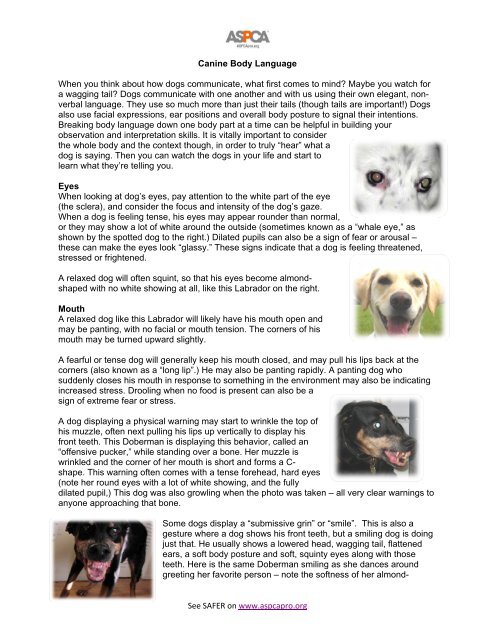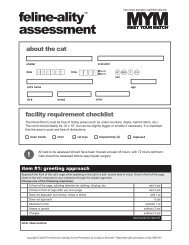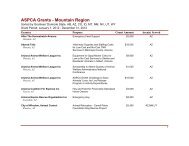Body Language Handout
Body Language Handout
Body Language Handout
Create successful ePaper yourself
Turn your PDF publications into a flip-book with our unique Google optimized e-Paper software.
Canine <strong>Body</strong> <strong>Language</strong><br />
When you think about how dogs communicate, what first comes to mind? Maybe you watch for<br />
a wagging tail? Dogs communicate with one another and with us using their own elegant, nonverbal<br />
language. They use so much more than just their tails (though tails are important!) Dogs<br />
also use facial expressions, ear positions and overall body posture to signal their intentions.<br />
Breaking body language down one body part at a time can be helpful in building your<br />
observation and interpretation skills. It is vitally important to consider<br />
the whole body and the context though, in order to truly “hear” what a<br />
dog is saying. Then you can watch the dogs in your life and start to<br />
learn what they’re telling you.<br />
Eyes<br />
When looking at dog’s eyes, pay attention to the white part of the eye<br />
(the sclera), and consider the focus and intensity of the dog’s gaze.<br />
When a dog is feeling tense, his eyes may appear rounder than normal,<br />
or they may show a lot of white around the outside (sometimes known as a “whale eye,” as<br />
shown by the spotted dog to the right.) Dilated pupils can also be a sign of fear or arousal –<br />
these can make the eyes look “glassy.” These signs indicate that a dog is feeling threatened,<br />
stressed or frightened.<br />
A relaxed dog will often squint, so that his eyes become almondshaped<br />
with no white showing at all, like this Labrador on the right.<br />
Mouth<br />
A relaxed dog like this Labrador will likely have his mouth open and<br />
may be panting, with no facial or mouth tension. The corners of his<br />
mouth may be turned upward slightly.<br />
A fearful or tense dog will generally keep his mouth closed, and may pull his lips back at the<br />
corners (also known as a “long lip”.) He may also be panting rapidly. A panting dog who<br />
suddenly closes his mouth in response to something in the environment may also be indicating<br />
increased stress. Drooling when no food is present can also be a<br />
sign of extreme fear or stress.<br />
A dog displaying a physical warning may start to wrinkle the top of<br />
his muzzle, often next pulling his lips up vertically to display his<br />
front teeth. This Doberman is displaying this behavior, called an<br />
“offensive pucker,” while standing over a bone. Her muzzle is<br />
wrinkled and the corner of her mouth is short and forms a Cshape.<br />
This warning often comes with a tense forehead, hard eyes<br />
(note her round eyes with a lot of white showing, and the fully<br />
dilated pupil,) This dog was also growling when the photo was taken – all very clear warnings to<br />
anyone approaching that bone.<br />
Some dogs display a “submissive grin” or “smile”. This is also a<br />
gesture where a dog shows his front teeth, but a smiling dog is doing<br />
just that. He usually shows a lowered head, wagging tail, flattened<br />
ears, a soft body posture and soft, squinty eyes along with those<br />
teeth. Here is the same Doberman smiling as she dances around<br />
greeting her favorite person – note the softness of her almond-<br />
See SAFER on www.aspcapro.org
shaped eyes, with no glassiness and no white showing at all. Teeth don’t always mean<br />
aggression – it is important to consider the whole body and the context to understand what a<br />
dog is saying.<br />
Yawning and lip licking may be an early sign of stress, particularly<br />
when accompanied by a tight mouth and often a whining sound, as<br />
this dog is doing. (She is being approached by a new, strange<br />
dog.)<br />
Ears<br />
Dogs have a wide variety of ear types. Although it may be easier<br />
for us to see ear position in dogs with erect ears, even floppy-eared dogs like Basset hounds<br />
can move the base of their ears forward and back to show different emotions – just look at the<br />
direction of the base of the ear. When a dog is relaxed, his ears may be slightly back or out to<br />
the sides. As a dog becomes more aroused, the ears will move forward, pointing toward a<br />
subject of interest. When their ears are most forward their foreheads often wrinkle.<br />
Tail<br />
When observing a dog’s tail, there are two things to consider: the position of the base of the tail,<br />
and how the tail is moving. A relaxed dog holds his tail in a neutral position, extending out from<br />
the spine (the middle photo below), or may be below spine level. The movement may be a loose<br />
wag from side to side or a sweeping circular motion. As the dog become more excited or<br />
aroused, his tail usually rises above spine level, as the picture to the right shows. As he<br />
becomes more aroused, the dog may hold his tail high with little movement, or he may move his<br />
tail side to side in short, rapid movements.<br />
A fearful dog will tuck his tail between his rear legs, as the first photo below shows. The tail may<br />
also be held rigid against the belly, or wag stiffly.<br />
See SAFER on www.aspcapro.org
Hair<br />
Much like your own “goose bumps,” the hair can raise<br />
along a dog’s back when he is upset or aroused. This is<br />
also known as piloerection or “raised hackles” and can occur across the shoulders, down the<br />
spine, and above the tail. Hackles don’t always mean aggression is imminent, but they are an<br />
indicator that the dog is excited or upset about something. A frightened<br />
or stressed dog may also shed more than usual.<br />
Sweat<br />
Dogs pant to cool themselves, but panting can also be a sign of stress,<br />
particularly rapid panting accompanied by a tight mouth with stress<br />
wrinkles around it. Dogs also have the ability to sweat through their<br />
paws. You may notice a dog leaving wet footprints on the floor if he is<br />
particularly upset.<br />
Overall <strong>Body</strong> Posture and <strong>Body</strong> Movement<br />
When initiating play, dogs often start with a play bow, as shown to the<br />
right, and generally follow up with<br />
exaggerated facial and body movements.<br />
A playful dog’s body movement will be loose and wiggly, with lots<br />
of movement and brief pauses during play. A dog who seems stiff,<br />
moves slowly, or who keeps moving away may not be interested in<br />
social interaction with this playful dog. Looking away, sniffing,<br />
scratching, lying down, or other avoidance behaviors may also<br />
indicate that the play session is<br />
over.<br />
A fearful dog may lean away, lean back, tremble, crouch,<br />
lower his body or head, or roll onto his side or back. Often,<br />
his eyes will often be fully open with large pupils, his<br />
forehead will be wrinkled, and his tail will be lowered or<br />
tucked. An extremely fearful dog may freeze completely or<br />
frantically try to escape, and he may urinate or defecate<br />
when approached.<br />
A dog displaying aggressive body language will look large,<br />
standing with his head raised above his shoulders. His body<br />
will be tense, with weight either centered or over all four feet or leaning slightly forward onto the<br />
front legs. He may also have a wrinkled muzzle, a short lip and a hard eye.<br />
Perhaps you can take what you’ve learned here to the dog park and try to spot some of these<br />
signals and behaviors. Pay close attention to what comes before, during and after each one.<br />
How will this new knowledge enable you to better meet the needs of the dogs in your life?<br />
See SAFER on www.aspcapro.org






